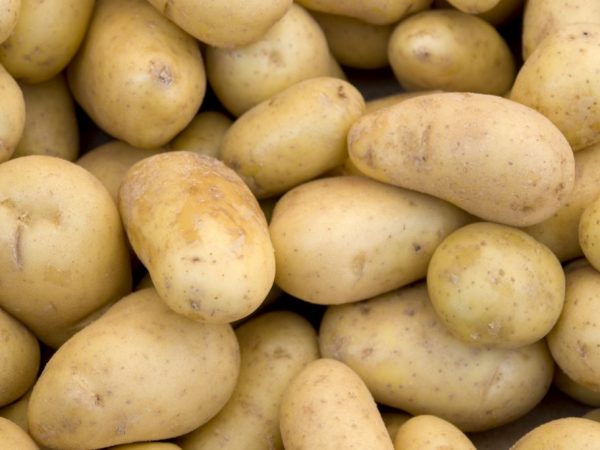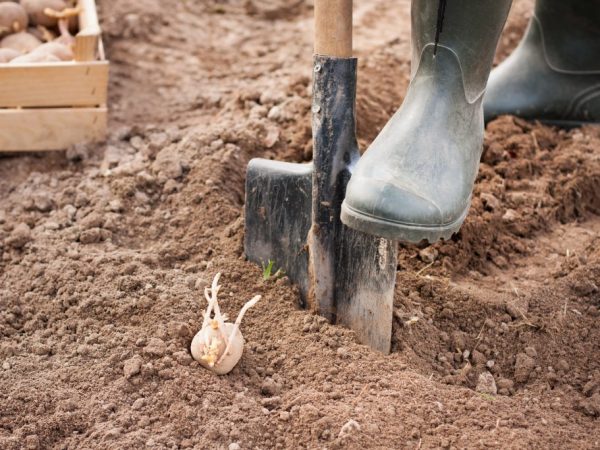Characteristics of Agatha potatoes
Potatoes are one of the most popular vegetable crops around the world. Today, there are many types of varieties that differ in appearance, taste, ripening, yield, etc. Agata potatoes - what is the peculiarity of its characteristics among other varieties?

Characteristics of Agatha potatoes
Characteristics of the species
Before describing the Agatha potato, you should refer to its origin story. Bred by breeders in the Netherlands. Officially registered in the State Register as a vegetable for cultivation in the central and Siberian regions of Russia.
Potato Agate has a description of the variety, from which it is clear that the fruits from this species can be obtained in the growing conditions of any soil. However, the richer it is and the better the farmer feeds the garden, the more fertile the crop will be. With proper care from 1 hectare, you can get up to 250 centners. The fruits ripen one and a half months after planting. The first tubers will appear in July, and the gardener will begin to harvest in August. The variety has high immunity against diseases such as nematode, marsha: only late blight poses a real danger to Agatha.
Plant characteristic
The bush is of medium size and straight upright. The foliage density is moderate, the leaf is small, with rounded teeth. Snow-white buds.
The developed root system forms 15 tubers from each bush. Almost all ripen to the end.
Description of the fetus
The early table type, to which the Agatha potato variety belongs, ripens and gains the required mass in a month and a half. Its main advantage is its adaptability to the poorest soils. What parameters does Agatha have:
- large fruit size - from 100 to 140 g;
- elongated oval shape, neat appearance, general identity;
- plain light yellow transparent peel;
- small outer eyes;
- the pulp is beige or yellow;
- the average starch content is 13%.
The fruits are rich in protein, vitamins and minerals, as well as a variety of amino acids. Ripe Agatha fruits can be eaten boiled, fried, baked; retain their color during heat treatment. The taste is full-bodied. Can be processed industrially. Transportable. The keeping quality of tubers is quite high.
Growing process
Before planting, it is necessary to make a careful selection of fruits: they should not be too large, whole and healthy specimens. The drug Fitosporin or Prestige will help the fruit to keep its presentation. Use products at the rate of 3 l / 1 l per 100 kg, respectively.
Experienced gardeners advise, one month before planting, to bring the seed potatoes indoors and place them in a box with an opening for light. So the tubers will sprout and begin to ripen and grow: such a process will have a positive effect on the dynamics and quality of the future harvest.
Both loamy and light fertile soil can be chosen as the planting site for the Agatha potato variety. As a fertilizer, ordinary manure (10 kg per 1 sq. M.) Or humus is suitable - it will be needed half as much. Treated with protective chemicals, it is planted from north to south in an open, sunny area. You can use the ridge method or the ridge method when planting seed potatoes. Wait until warm and dry weather sets in.

Only healthy tubers are suitable for planting.
Pay attention to the sufficiency of the fruit feeding area. The distance between the rows should be at least 75 cm, so you will also facilitate the process of caring for the beds. As for the plants themselves, leave the gap between them at 25-30 cm.
When landing, use the Force tool - this is a reliable protection against wireworms. Aktara, introduced during planting in the bottom, as well as wood ash in the holes, will help to stop the attack of the plant by pests.
Seedling care
Easily adapting to environmental conditions, Agatha potatoes still require compliance with certain rules in relation to themselves. To get a rich harvest in quality and quantity, the farmer must take into account the following regulations.
- hygiene and timely weeding;
- surface loosening during the entire period of development of the vegetable crop;
- mulching the soil with dry grass or straw to increase fertility;
- hilling tops before the budding process begins;
- weeding weeds by hand or using herbicides;
- the introduction of potassium and magnesium, as well as organic fertilizers into the soil, even fertile in itself: three dressings per season are enough, if there is no particular need to increase the dose;
- foliar feeding of 10 g of superphosphate per 1 m2 for the purpose of feeding the tubers - is carried out 30 days before harvesting.
When applying nitrogen fertilizers to the soil, do not overdo it with their amount: the high content of nitrates in the resulting fruit makes it harmful to the human body.
Abundant watering of vegetable seedlings is no less important, especially during drought periods. A drip system will become a convenient way for the owner.
Viruses and diseases
If the fruit crop is infected with fungal viruses, use Revus at a dosage of about 300 liters per hectare. If one time is not enough, repeat the procedure, but not earlier than 14 days after the previous treatment.
Beware of contamination of the vegetable with late blight - neglected cases are fraught with the death of the entire crop. If you notice dark spots on the lower leaves of the plant, gradually creeping to the top, and then to the roots and stems, it's time to sound the alarm. The infected fruit becomes slimy, turns gray, its pulp acquires a rusty hue. Weed out spoiled tubers immediately, as the infection spreads very quickly. Urgently subject the rest of the field to fungicides such as Artsdil or Ridomil: perhaps one time will not be enough.
Preventive measures in this case include treating the seed with immunocytophyte and drying the fruit after harvest. To protect the crop from the invasion of Colorado beetles, apply Antonem's water solution (800 liters per 1 ha) to the surface of the garden bed during the flowering period.
Farmers reviews
Garden owners appreciate the culture for its unpretentiousness in relation to the soil and climate and early ripening, which gives a bountiful harvest - up to 1 kg per bush. Agatha's resistance to diseases is not ignored. To ensure good yields, it is necessary to establish a clear irrigation system, abundantly feed the soil and regularly loosen it for better oxygen supply to the tubers.
Housewives praise the fruits of Agatha potatoes for their pleasant taste and crispness, which is convenient for preparing certain dishes - this data is also confirmed by the characteristic.


